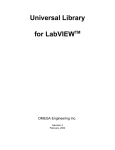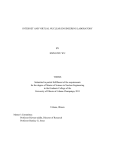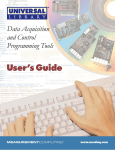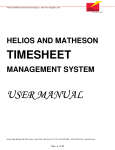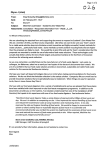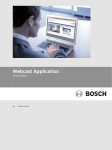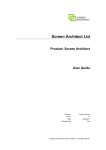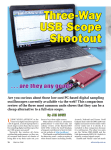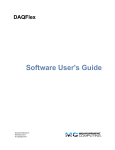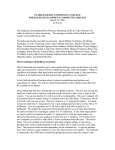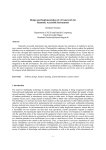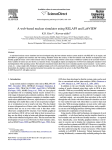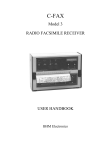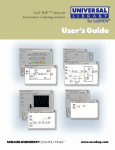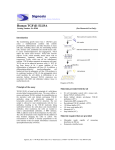Download Broadcasting Engineering Laboratories
Transcript
Advances in Engineering Education Summer 2008 Broadcasting Engineering Laboratories—Audio/Video and Data—In Real-Time Over the Internet PRASHANT K. JAIN Department of Nuclear, Plasma and Radiological Engineering University of Illinois at Urbana—Champaign Urbana, IL YUXIANG GU Department of Nuclear, Plasma and Radiological Engineering University of Illinois at Urbana—Champaign Urbana, IL RIZWAN-UDDIN Department of Nuclear, Plasma and Radiological Engineering University of Illinois at Urbana—Champaign Urbana, IL ABSTRACT Internet extends the reach of existing laboratory and training infrastructure to beyond the walls of such facilities. Though nothing can replace the hands-on experience in a laboratory; a carefully developed web-based digital lab may be the next best thing. In some cases, there may be benefits associated with a “distance laboratory” that are usually not available in a conventional lab. Due to radiation environment and very high cost of some labs—for example, nuclear research reactors—there exists a need to develop web-based systems that can access the experiments being conducted in a radiation measurement lab or the reactor and make it available in a virtual laboratory. These systems should be inexpensive, easily installable, allow interactive audio/video communication as well as remote access (or sharing) of data in real-time. We here report the development of a real-time, distance lab module that is being implemented in the Department of Nuclear, Plasma and Radiological Engineering at the University of Illinois. This internet-based system allows remote personnel to watch the experiments and personnel performing the experiments, acquire data, and interact (audio and video) with on-site personnel. Data are broadcasted in real time in text as well as graphical format—the same format used to display the data on site. Moreover, use of LabVIEW’s remote front panel feature allows communications between the local lab and remote client so that remote client, if permitted, can obtain part or full control of the experiments. Keywords: Web-cast, e-Lab, Internet, LabVIEW, Distance education summer 2008 1 advances in engineering Education Broadcasting Engineering Laboratories—Audio/Video and Data—In Real-Time Over the Internet INTRODUCTION The internet and world-wide-web have become indispensable parts of modern day education, supplementing existing classroom education and also supporting web-based courses and programs. Though the distance learning programs continue to expand, real-time broadcasting of engineering laboratory courses is still in its infancy. In addition, for expensive and/or dwindling experimental facilities—such as teaching, training and research nuclear reactors—distance lab modules may become an economic necessity [1]. While distance-lab modules—just like distance-courses—may never be as meaningful as their in-lab counterparts, it may be possible to make them somewhat realistic. Moreover, in some ways, distance-labs (or e-Labs) with their large screen monitors and zoom-pan capabilities associated with the broadcasted video, might actually provide a more meaningful experience than a passive presence in the back of a crowded laboratory. (Somewhat similar to the experience of watching a soccer game on wide screen HDTV with replays from several different angles and multiple windows vs. watching it live from the top of a large stadium.) Additionally, embedded multimedia features along with interactive simulations may also allow remote users to visualize and grasp different dynamic concepts, which in turn, can promote active learning. [In a way, these digital tools and features—like multi-media interactive features, large screen with multiple windows, and replay capabilities—are meant to enhance our understanding of real phenomena and thus, can and should be used even in the hands-on laboratories. And it is in this sense that the in-lab experience can always be enhanced to have an edge over the distance-lab.] Recently, several efforts have been made towards the development of web-based laboratories. Rohrig and Jochheim [2] reported a Virtual Lab to remotely access control engineering experiments at the University of Hagen, Germany. The approach is based on client/server architecture written in JAVA. Gurocak [3] presented a novel method for distance delivery of a manufacturing automation laboratory course among different campuses of Washington State University (WSU) by linking them with an interactive TV system called WHETS. In this model, each site has its own complete physical laboratory. All students must assemble in one of these remote labs. Moreover, there is little interaction with the instructor and little flexibility in controlling the experiments from remote sites [2, 3]. Henry and Nuttal [4] and Henry and Zollars [5] have developed remote webbased labs using LabVIEW technology to broadcast control and chemical engineering experiments [5]. Efforts are also underway in some nuclear engineering departments towards development of distance lab capabilities [6–14]. For example, both North Carolina State University [6] and Penn State University [7] have developed modules to provide access to their reactor labs via the internet. Moreover, University of Illinois [8–12], University of Wisconsin [13] and University of Massachusetts [14] are also actively engaged in similar developments. 2 summer 2008 advances in engineering Education Broadcasting Engineering Laboratories—Audio/Video and Data—In Real-Time Over the Internet In this paper, we report recent developments in efforts at the University of Illinois to build a framework that exploits mostly off-the-shelf-technology to develop an e-Lab module for distance education. The implementation methodology is described in detail for a couple of experiments, and it is hoped that this paper could be a valuable resource for educators who want to develop similar concepts for other experiments. METHODOLOGY The distance lab module has four components: local lab; LabVIEW [15]; one or more webcams; and remote client. Figure 1 shows a schematic diagram of the system. “Local lab” includes experimental setup at the local facility and personnel carrying out the experiment. “LabVIEW” is a software package marketed by National Instrument (NI) that is capable of signal acquisition, analysis, and data presentation. It also has built-in capability to webcast data in graphical and other formats. Moreover, LabVIEW also allows communications between the local lab and remote client so that remote client can be given full access to control the experiment. Webcams are now Figure 1. A schematic diagram of the distance lab. summer 2008 3 advances in engineering Education Broadcasting Engineering Laboratories—Audio/Video and Data—In Real-Time Over the Internet well known and even good quality webcams are increasingly becoming affordable so that even multiple webcams can be installed in a single lab. “Remote client” may be any computer connected to the internet. Arranging these four components into a virtual lab requires compatibility between hardware and software. For example, the experiments must have data acquisition hardware capable of communicating with LabVIEW, which must have the data acquisition driver installed. LabVIEW applications are usually experiment-specific. To webcast the data, the computer running LabVIEW must be connected to the internet. Different kinds of web cameras are now available. Most desirable is a web camera that is controllable (zoom, pan) through a standard web browser, even by the remote user. The camera should have fast frame rates, high resolution, large bandwidth, and preferably a built-in microphone. Internet-ready webcams are also available—that do not need a computer to be connected to the internet. The remote client needs a computer with multimedia and internet. It needs installation of some runtime engines (which are available free of cost) to capture and display the live camera shot and to display the LabVIEW web-cast. In order to test the capabilities of the e-Lab at the receiving end, Department of Nuclear, Plasma and Radiological Engineering at UIUC (http://www.engr.uiuc.edu/ne/) has also developed a computer lab equipped with two large screen monitors and several computers. It is also equipped with internet-ready web-cameras that are controllable from remote locations with zoom/pan/tilt capability. Figure 2 shows a picture of the two large screen monitors mounted on a wall. Web browser windows are showing different shots of the laboratory, live video shot of the experiment and displaying the data being measured in real-time. This extensive information of a real-time experiment can be displayed on these screens for a large number of students to view. Several modalities for an audio link between the remote computer lab and the experiment site, including conference calling and an audio transmission feature built into the webcam, are also available. To test one particular webcasting of an experiment, the Centra web-based meeting software [16] was also installed at the transmitting and receiving locations. Use of this specific package enables bi-directional audio and video communication to/from the webcasting and receiving sites. Choice of devices and software for this project was dictated by several goals and limitations. In the model of the e-Lab presented here, LabVIEW was chosen as the base platform to provide the link between the experiment, computer and the internet due to its embedded remote broadcasting feature. This feature allows any PC or laptop to become a data-acquisition device as well as a web-server without installing any additional software. Moreover, LabVIEW platform can easily be customized and made interactive as per the needs of the user. In choosing the appropriate web-cam, the cost of the equipment as well as the resolution and streaming capabilities were the 4 summer 2008 advances in engineering Education Broadcasting Engineering Laboratories—Audio/Video and Data—In Real-Time Over the Internet Figure 2. Remote client facility at the University of Illinois showing the heat transfer experiment to a group of students. deciding factor. Moreover, docking capabilities with other gadgets (such as microphones, etc) can be enhanced with the addition of a multi-terminal module. In addition, the network control feature in the primary webcam chosen eliminates the need for a computer that controls the camera. That is, this camera is controllable over the internet from any computer hooked to the network, thus, introducing more flexibility. Security feature available in this camera does allow the camera host to restrict access to specific IP addresses only. Additional, less expensive web-cams that do not have these extended features are also installed. EQUIPMENT DESCRIPTION AND EXPERIMENTS Experiment-specific details of the four components of this e-lab are described in detail in this section. Details are given for a heat transfer experiment. Later, a gamma ray spectroscopy experiment is briefly described. summer 2008 5 advances in engineering Education Broadcasting Engineering Laboratories—Audio/Video and Data—In Real-Time Over the Internet Local Lab Experiment and Experimental Set-Up: A boiling heat transfer experiment used in a laboratory course in the Department of Nuclear, Plasma and Radiological Engineering—to measure the heat transfer coefficient before, during and after film boiling—has been modified for the e-Lab demonstration, and tested. The purpose of this experiment is to provide physical understanding of the phenomena that are characteristic of various boiling regimes [17], and to measure the heat transfer coefficient in different boiling regimes. Figure 3 shows a picture of the test bench, showing the kiln on the right. In the first stage of the experiment, a metal ball is heated to nearly 420 C, and then submerged in a pool of near boiling water. Different stages of this experiment are shown in Figure 4. There are two thermocouples embedded in the sphere. One is placed very close to the surface of the sphere and measures the surface temperature, Ts. The other is located at a selected radius inside the sphere and measures the inside temperature representative of sphere’s average temperature, Tavg. This value when measured as a function of time, can be used to determine the heat flow rate from the sphere, Q, given by where V is the volume of the sphere. The heat transfer coefficient, h, is obtained from Newton’s law of cooling, which is Figure 3. Boiling heat transfer experiment set-up. 6 summer 2008 advances in engineering Education Broadcasting Engineering Laboratories—Audio/Video and Data—In Real-Time Over the Internet Figure 4: Experimental procedure. Steel or copper ball with two thermocouples (left); ball heated to nearly 420 C (center); heated ball submerged in near boiling water (right). where A is the heat transfer area and T is the difference between surface temperature and the fluid bulk temperature [18]. As the hot sphere is dipped into the pool of water, it first leads to film boiling where a vapor film can be clearly distinguished around the sphere (see Figure 5(a)). Heat transfer rate during this stage is low. Thus, sphere’s surface and inside temperatures slowly decrease with time. When the vapor film starts to break down and water comes in contact with the hot sphere, there is violent and vigorous boiling (see Figure 5(b)). Consequently, there is rapid heat transfer, and over a few seconds the temperature drops significantly. By repeating the experiment with a copper and then with a steel ball, the relative difference between the surface and inside temperature indicates the difference in thermal conductivities of both the materials. Besides the post experiment analysis of data, simultaneous observation of different stages of boiling (a window showing the experiment) and associated thermocouples readings (a window showing the thermocouple data being measured) is an instructive experience of this experiment, which makes it an excellent candidate for this prototype e-Lab. Figure/Video 5 shows different stages of boiling. Data Acquisition Instrument: The experiment uses a USB-based temperature measurement device, USB-TEMP [19] (from Measurement Computing Corporation), that provides eight differential temperature input channels and supports all of the common sensor-type thermocouples, RTDs, thermistors and semiconductor temperature sensors. A picture of the device is shown in Figure 6. It provides flexibility in temperature measurement as each channel can monitor any of the supported input types. Thermocouples’ signal is fed into the USB-TEMP, which is then connected to the PC via a USB port. summer 2008 7 advances in engineering Education Broadcasting Engineering Laboratories—Audio/Video and Data—In Real-Time Over the Internet Figure/Video 5. Different boiling regimes observed during the heat transfer experiment: (a) film boiling; (b) vigorous boiling after the vapor film starts to break down. This device also has an open thermocouple detection feature which lets user detect a broken thermocouple. Moreover, an onboard microprocessor automatically linearizes the measured data according to the sensor category. In addition, it is a standalone plug-and-play module which draws power from the USB cable, i.e., no external power supply is required [19]. USB-TEMP has its own driver software which needs to be installed on a computer before it can be used for data acquisition. When the device is connected for the first time, the computer automatically detects and installs it. All hardware configuration options, for example, sensor type for each channel, are programmable with the software provided with the device. Moreover, its calibration utility tool automatically calibrates the device, minimizes thermal drift and retains the rated accuracy of measurements. LabVIEW (Laboratory for Virtual Instrumentation and Electronics Workbench) LabVIEW is a graphical programming language, developed by National Instruments, with built-in tools designed specifically for measurement and control. It is similar to traditional programming languages like FORTRAN or C—it allows variables, data types, loops, sequencing 8 summer 2008 advances in engineering Education Broadcasting Engineering Laboratories—Audio/Video and Data—In Real-Time Over the Internet Figure 6. USB-TEMP; a plug-and-play device for temperature measurement. Signal from the two thermocouples is the input to this device; while the output is transmitted through a USB connecting wire to the PC [3]. structures, etc. Moreover, it provides very efficient and up-to-date tools for acquiring, analyzing and presenting measured data. Each interface or window in LabVIEW is called a Virtual Instrument (or VI), which is a primary building block of the application and allows modularization of the code for efficient design and handling. Each VI is composed of two main components; the front panel and the block diagram. The front panel of the user interface is created by dragging and dropping controls and indicators from the programming palette, which are, respectively, the interactive input and output terminals of the VI. Controls are knobs, pushbuttons, switches, dials and other input devices. Indicators are graphs, LEDs and other displays. Every front panel control or indicator has a corresponding terminal on the block diagram. The block diagram represents the source code in a graphical format. In addition, the block diagram contains functions and structures from built-in VI libraries. All the nodes in the block diagram, including control and indicator terminals, functions and structures are connected showing the flow of information and control. When a VI is run, the block diagram is executed, and the data is passed from one station (functions or indicators) to the next, as in a traditional computer program, where they are used in the functions on the diagram, and the results are passed to yet other functions or indicators [15]. summer 2008 9 advances in engineering Education Broadcasting Engineering Laboratories—Audio/Video and Data—In Real-Time Over the Internet A software called “Universal Library (UL) for LabVIEW” is provided with the data acquisition (DAQ) device used in this experiment, USB-TEMP. This software allows the development of customized LabVIEW applications compatible with the DAQ hardware. To read the temperature inputs via LabVIEW, an example program (TInScan.VI) supplied with the UL package was modified. This VI reads a range of temperature input channels and returns the temperatures to an array (in degrees) which can be displayed graphically and webcasted. Moreover, a feature called remote front panels allows users to view and control the VI front panels remotely from a web browser without any additional programming. The user can switch the display between different quantities being measured. A remote user connected via the web can run an application or check progress. Additionally, several users at different locations can access the VI simultaneously and view “live” updates to the front panel window through any standard browser. However, for obvious reasons, only one client can control the front panel at a time [15]. Figure 7 shows the front panels of the VI for the boiling heat transfer experimental set-up. Figure 7(a) shows a simple schematic diagram of the experimental setup and a brief description. This feature can be used to develop description of the lab and reading material for lab preparation. By clicking on the experiment tab in Figure 7(a), one can switch to Figure/Video 7b which shows the data being measured in the experiment. This window shows the surface and near-average temperature being measured. Block diagram corresponding to this lab is shown in Figure 8. Arguments on the left side of TIn Scan box in the block diagram, represent different inputs, while temperature output is fed into a chart utility box to generate the graphs. Various inputs such as BoardNum, LowChan and HighChan specify the board number, and first and last channels to scan, respectively. Units for temperature output can be set from the Scale button, with options available for Celsius, Fahrenheit and Kelvin. Webcam Canon VB-C50i PTZ Network Camera [20] is used as the primary webcam for video monitoring and web casting. This camera is capable of transmitting videos at up to 30 frames per second (see Figure 9(a)). The camera’s built-in web and FTP server supports 50 viewers to simultaneously access the system. With a 26x optical and 12x digital zoom-in feature and 200 panning/120 tilting feature, remote client can virtually access any part of the real-time experiment. In addition, this camera offers two-way audio capability when Canon VB-EX50 MultiTerminal Module is added (see Figure 9(b)). With this module, microphone and speakers can be connected to the camera, allowing remote monitoring of audio at the experimental site or even two-way communication between the lab and the remote site. Two additional (secondary) webcams are also installed in the lab. 10 summer 2008 advances in engineering Education Broadcasting Engineering Laboratories—Audio/Video and Data—In Real-Time Over the Internet Figure/Video 7. (a) Front panel of the VI for the boiling experiment. (b) Remotely controlled LabVIEW front panel displaying real-time temperature data. Picture shows increasing temperatures as the ball is being heated in the furnace. Subsequent drop in temperatures due to quenching is shown in the video. summer 2008 11 advances in engineering Education Broadcasting Engineering Laboratories—Audio/Video and Data—In Real-Time Over the Internet Figure 8. Block diagram for the heat transfer experiment—graphical source code. Figure 9. (a) Canon VB-C50i PTZ Network Camera; (b) Canon multi-terminal module (VB-EX50). [5] Remote Client The remote clients only need a web browser to log into the web sites. Remote computers must have LabVIEW Run-time Engine and Java Runtime Engine (JRE) installed. LabVIEW runtime engine is needed to receive and display the data while Java runtime engine is needed for the Canon webcam. These are free to download from www.ni.com and www.java.com, 12 summer 2008 advances in engineering Education Broadcasting Engineering Laboratories—Audio/Video and Data—In Real-Time Over the Internet Figure/Video 10. A view of the webcast of the heat transfer lab as seen in a web browser at the remote site. Remote user can zoom, tilt and pan using the scroll bars on the bottom and right side of the window. respectively. Figure/Video 10 shows a webcam view as seen in a web-browser at a remote site. For this particular camera, in addition to pan-tilt-zoom control, remote user can also adjust the background light. The two-phase boiling heat transfer e-Lab has been installed and tested by conducting the experiment, webcasting it and having a set of students “participate” in the lab remotely via internet. Along similar lines, a gamma ray spectroscopy experiment has also been modified and tested for online e-Lab. In this experiment, gamma ray energy is estimated (locally and at remote site) by measuring voltage produced in the NaI (Tl) scintillation detector. A view of the detector and other apparatuses, as seen in a web browser on the monitor of a remote computer, is shown in Figure 11(a). Of course, remote user can zoom in/out to see any specific component in more detail. Figure 11(b) shows a computer remotely accessing the webcasted window of the voltage fluctuation data. summer 2008 13 advances in engineering Education Broadcasting Engineering Laboratories—Audio/Video and Data—In Real-Time Over the Internet Figure 11. Data being acquired in the gamma ray e-spectroscopy lab, shown in a web browser at the remote site. (a) Screen capture of video web-cast (b) Voltage data acquisition on a remote computer. 14 summer 2008 advances in engineering Education Broadcasting Engineering Laboratories—Audio/Video and Data—In Real-Time Over the Internet CONclusIONS Using off the shelf technology, a boiling heat transfer e-Lab has been developed that can be a prototype for other similar experiments. The e-Lab successfully achieves the goals set out for such an exercise. It provides a rather realistic experience of the experiment to the student at the remote site. Although current emphasis has been on observation, data retrieval, and analysis of particular experimental sequences that illustrate or reinforce some basic physics or engineering concepts, future developments may also allow some limited control actions from the remote sites. With LabVIEW, internet and computers readily available in most laboratories, web-casting of these labs over the internet to sites around the world can be achieved with a modest cost. This prototype e-Lab will facilitate reaching a broader audience and enhance distance education programs. More importantly, it is hoped that the details provided in this paper will help in the development of other similar e-Labs. ACKNOWLEDGEMENTS This work is supported in part by a DOE—INIE grant. Support from the College of Engineering at the University of Illinois at Urbana-Champaign under an “Innovations in Teaching” grant is also acknowledged. Authors wish to thank Prof. James F. Stubbins and Prof. Barclay G. Jones for their support and encouragement. Assistance by Qi Lou, Stefano Markidis, Mike Sorice, J’Tia Taylor and Hsingtzu Wu is greatly acknowledged and appreciated. REFERENCES [1] Y. Gu and Rizwan-uddin, “Real-time, distance Lab via LabVIEW and webcam,” Trans. ANS, Vol. 92 (2005). [2] C. Rohrig and A. Jochheim, “The virtual lab for controlling real experiments via internet,” Proceedings of the 1999 IEEE, International Symposium on Computer Aided Control System Design, Hawaii, USA (1999). [3] H. Gurocak, “e-Lab: An electronic classroom for real-time distance delivery of a laboratory course,” Journal of Engineering Education, Vol. 90, pp. 695–705 (2001). http://www.asee.org/publications/jee/PAPERS/display. cfm?pdf5414.pdf [4] J. Henry and E. Nuttal, “Chemical engineering experimentation over the internet,” AIChE Annual Meeting, Paper 501a (2003). [5] J. Henry and R. Zollars, “Introducing reality into process control classes,” ASEE annual meeting (2005). http://chem. engr.utc.edu/jim-henry/jmh-references.htm. [6] G. Meyers and R.M. Edwards, “Internet access to reactor control experiments”, Proceedings of the fourth ANS International Topical Meeting on NPIC and HMIT, American Nuclear Society (2004). summer 2008 15 advances in engineering Education Broadcasting Engineering Laboratories—Audio/Video and Data—In Real-Time Over the Internet [7] L.F. Miller, A.I. Hawari, and A. Cook, “Internet university reactor experiments for education in nuclear engineering,” Trans. ANS, Vol. 91, 957–958 (2004). [8] K.D. Kim and Rizwan-uddin, “A web-based nuclear simulator using RELAP5 and LabVIEW,” Nuclear Engineering and Design, Vol. 237, 1185–1194 (2007). [9] Y. Gu and Rizwan-uddin. “UIUC’s contribution to Big-10’s INIE project,” Proceedings of the PHYSOR-2004, 2067–2077 American Nuclear Society (2004). [10] P.K. Jain, Y. Gu, J.F. Stubbins, and Rizwan-uddin, “Broadcasting nuclear engineering laboratories — video and data—in real-time over the internet,” Proceedings of the ASEE Annual Conference, Chicago, USA, June 18–21 (2006). http://www.asee.org/acPapers/code/getPaper.cfm?paperID510935&pdf52006Full2354.pdf [11] P.K. Jain, J.F. Stubbins, and Rizwan-uddin, “Interactive virtual laboratory for distance education in nuclear engineering”, Proceedings of the PHYSOR 2006 topical meeting, Vancouver, Canada, Sept 10–14 (2006). [12] K.D. Kim, P.K. Jain, and Rizwan-uddin, “Web- and system-code based, interactive, nuclear power plant simulators,” Proceedings of the International Topical Meeting on Nuclear Plant Instrumentation, Control and HumanMachine Interface Technologies, Albuquerque, USA, Nov 12–16 American Nuclear Society (2006). [13] E. Edwards, A. Sweet, M. Blanford, R. Agasie, P.K. Jain, and Rizwan-uddin, “Distance reactor laboratory and virtual tours,” Trans. ANS, Vol. 94 (2006). [14] P.K. Jain, S. Markidis, B.G. Jones, Rizwan-uddin, J.R. White, and L. Bobek, “Web-casting of nuclear reactor experiments,” Trans. ANS Winter Meeting and Technology Expo, Albuquerque, USA, Nov 12–16 American Nuclear Society (2006) [15] LabVIEW 7.1, National Instruments, http://www.ni.com/, Hands-On Campus Workshop Manual, Sept 2003 Edition (2005). [16] Centra Live for e-Meetings, http://www.saba.com/. [17] L.S. Tong and Y.S. Tang, “Boiling heat transfer and two phase flows,” CRC (1997). [18] NPRE-451 Lab Manual, Department of Nuclear, Plasma and Radiological Engineering, University of Illinois at Urbana-Champaign, USA (2005). [19] USB-TEMP, Temperature Measurement Module, Measurement Computing Corporation, User’s Guide (2005). [20] Canon Inc., VB-C50i PTZ Network Camera, User’s Manual (2005). AUTHORS Prashant Jain is a doctoral student (nuclear engineering) at the University of Illinois at Urbana Champaign. He is interested in developing computational tools to enhance engineering education. Yuxiang Gu is a doctoral student (nuclear engineering) at the University of Illinois at Urbana-Champaign. His interests are in computational methods and CFD. 16 summer 2008 advances in engineering Education Broadcasting Engineering Laboratories—Audio/Video and Data—In Real-Time Over the Internet Rizwan-uddin is professor of Nuclear, Plasma and Radiological Engineering at the University of Illinois at Urbana-Champaign. He is interested in the use of technology to develop experiential learning tools for teaching enhancement and improved retention. He holds a PhD in Nuclear Engineering from the University of Illinois. Address Correspondence to: Rizwan-uddin 216 Talbot Lab, 104 S. Wright St. University of Illinois at Urbana Champaign Urbana, IL 61801 Tel: (217) 244 4944; Fax: (217) 333 2906 E-mail: [email protected] summer 2008 17

















